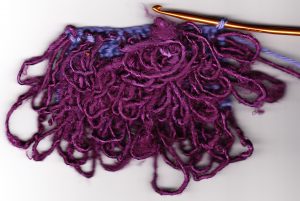When researching crochet to answer my specific questions, and broaden my understanding of the craft, I found the homepage for the Crochet Guild of America(CGOA), which immediately proved to be a valuable resource. They are a non-organization, and although some services are only provided through a members fee, they offer a plethora of free information and links to crochet-related resources. I was able to answer most of my crochet queries using this site as reference .
What is the cultural history of crochet? In turn, am I being culturally insensitive by picking it up?
-While the true origins are unknown, the practice of crochet can be traced far through French and Norse history. There are multiple theories of the place of origin: South America, Arabia, and China have all been suggested. Similar practices like knitting, weaving, and embroidery date much further back. Some believe that the modern, “true crochet” emerged in the 16th century. It is safe to say that there is much debate regarding the true origins of crochet. Based off the array of origin theories, I doubt there are concerns regarding cultural sensitivity of the practice. Further information regarding the history of crochet can be found on the CGOA history page\
-Before the mid-1800’s all crochet patterns were learned by copying the finished product, or a section of it. The earliest recorded prints of patterns are from 1824.
What can be made with crochet?
-Woven fibers were are thought to have been used initially for handiwork like nets, traps, and game bags. Over time personal decorations and ornaments were made. In the 19th century the uses for crochet expanded to include things like covers for birdcages, foot warmers, and tobacco pouches. The 20th century marked the emergence of crochet teapot cozies, car rugs, and hot-water bottle covers. It appears that crochet is a versatile platform where it’s utility is only limited the creativity of those practicing it. Please click here if you would like to read more about the uses of crochet.
What materials are necessary for crochet? Do they vary, and if so, why?
-The main tool for crochet is a hook, I previously thought that they were called needles. The materials used for hooks have included metal, wood, various types of bone, horns, and ivory. The woven material itself has varied immensely through time, but materials like hair, fur, sinew, hemp, cotton, wool, metallic strands, linen have been prevalent.
Are there different styles of crochet? If so, what style(s) will I attempt to learn?
-Techniques have changed over time, in the early 1800’s it was popular to hold the yarn and hook in the same hand, which people currently hold the hook in their dominant hand, and the yarn in the off-hand. There are right and left-handed instructions for different crochet projects. I write left-handed, so it is likely I will be following the left-handed instructions.
-As time has progressed more ways to create loops and different patterns have emerged, resulting in a broaden of techniques. In the 1800s hooks were only inserted into the back-half of a stitch unless specified, while today the hook passes through both loops unless specified. Being aware of this change would be useful if I ever try to follow an antique set of instructions.
Where am I going to source my materials?
-I would like to source yarn from thrift stores as I become more material-savvy, but initially I am likely going to go to Michael’s art supplies or a similar store so that I can talk with a knowledgeable staff and see if they have any recommendations for beginners.
What resources am I going to use for my background research and for learning the practice?
-The homepage for the CGOA is a serious wealth of information, and I will use the resources provided there to learn the basic techniques. The CGOA has a Learn Crochet page that provides lessons for beginners.
Do I need to pick a project to complete or are there ways to “dip my toes” into crochet?
-I am going to start by following the “learn to crochet” instructions for left-handed people on the CGOA site, but I am still unsure of what size of yarn I will need.
-A quick google search led me to a “100 easy crochet patterns” page on The Stitching Mommy, from which I found a pattern for a “soap-saver” bag. I’m hoping to use the bag to carry the large number of dice needed for Dungeons and Dragons. For this project I will need 2 colors of category 4 medium yarn, 35 yards of the first and 1 yard of the second.
Having answered by questions, I now feel prepare to go purchase supplies and to officially start crocheting! Check back soon to see my progress.



Recent Comments